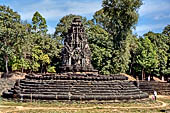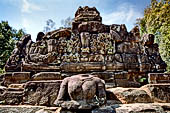In the middle of the now dry Northern Baray, Neak Pean (its original name was Jayasri) is a series of ‘srahs’ (pools) with in the middle a temple shrine on an island. This is the ‘Mebon’ of the Prah Khan baray (the “Jayatataka” of the inscription) with Preah Khan, the main temple, aligned on the same east-west axis axis with Neak Pean at the centre and Ta Som, a smaller temple complex, to the east.
Neak Pean |

|
The large square pool is bordered by steps and has at its centre, surrounded by similar steps, a circular island with a small sanctuary. Four secondary pools flank the main pool on each axis. The water from the main basin is gushed from four chapels into the lateral ponds. The four chapels are set into the steps of the central pool and are all similar. Each one is open to the secondary pool with a gargoyle. The four buildings served for the ablution of the pilgrims who hoped to be cured. To the north the gargoyles is in the form of an elephant’s head, a horse’s head to the west a lion’s to the south and a human head to the east.

|
Neak Pean
|
The prasat of the inner platform is a two tiers Buddhist sanctuary sitting on an enormous lotus corolla base. The plan is cruciform with four doors, in the inward corners of the cross a three headed elephant similar to the one of the gates of Angkor Thom. Only the eastern door is open east, the other three are false doors walled with sculptures of
Lokesvara. The sculptures of the frontons are dedicated to the life of Buddha. Two nagas surround the base of the circular island with their tales entwined. This gives the temple its modern name, which means ‘entwined snakes’.
To the east there is the remarkable sculpture of the flying horse Balaha, the bodhisattva
Lokesvara in his horse incarnation, carrying according to the legend the rescued merchants from Ceylon hanging from its tail. Unfortunately the major part of the sculpture is missing.
Neak Pean |

|
Although controversial the symbolism of Neak Pean is recognised in a replica of the sacred lake Anavatapta, venerated in India for the healing powers of its waters. The lake at the foot of the Kailash Mountain in Tibet is the source of the four rivers of the earth that flow at the four cardinal points, corresponding to the four sculpted gargoyles: the man’s head, on the west, representing the Ganges; on the north, an elephant’s head, symbolizing the Tarim; on the east, a horse, standing for the Oxus; and on the south, a lion, the sign of the Indus
river.
|
|
|



